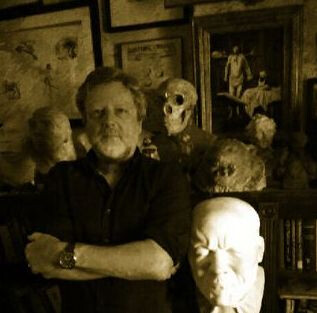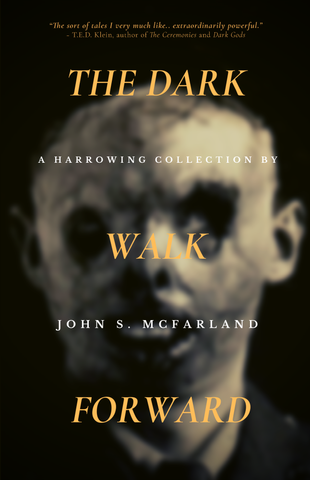
PB – Tell me a bit about yourself and what got you started in horror writing.
JM: I have always been a fan of horror. As a young kid, I loved the old Universal classic movies, Frankenstein and Dracula and the whole crew, as well as the giant monsters of the 1950s, the postwar dread of the new atomic age. I also loved the Roger Corman Poe films of the 1960s. I mention movies because like a lot of young people, the movies moved me toward reading the stories, and discovering that the original literary versions of many of my favorite tales were much more complex than the film versions. In my teens, I discovered a volume called The Modern Library Great Tales of Terror and the Supernatural. This book was pivotal for me. In addition to Poe, with whom I was well acquainted by then, it gave me an introduction to and love for the great horror stories of the 19th and early 20th centuries. It was my first introduction to M. R, James, H. P. Lovecraft, Robert Hitchens, Arthur Machen, Joseph Sheridan LeFanu, and many others.
PB – What kind of research and background did you use to create the town of Ste. Odile or is it based on your own experience?
JM: Ste. Odile is based on the real old French colonial Mississippi River town of Ste. Genevieve, founded in 1732, which is about 60 miles south of St. Louis. My fifth great-grandfather, orphaned in an Indian raid as a toddler in 1750’s Pennsylvania, was bought from the raiding party by the parish priest of nearby Fort De Chartres for 5 barrels of whiskey, and as an adult became one of the patriarchs of Ste. Genevieve. Having discovered the regionalism of William Faulkner and Flannery O’Connor, I wanted to do the same for horror and make my fictional town sort of the Yoknapatawpha County of Hell. Coming up with a name for my town was a challenge. I liked names that started with an ‘O’ and the name Odile appeared on many a gravestone in the town’s ancient cemetery, so that’s the name I chose. The first expression of my horrific regionalism came in my 2010 novel The Black Garden, in which the region as well as many characters I still reference, first appeared. Two years ago, traveling in France and Alsace, my wife and I were stunned to find there is a REAL Ste. Odile: a mountaintop retreat dating from the 8th century.
PB – It seems your writing spans time periods. What inspires you to pick a certain time period to write in?
JM: My love of the aforementioned 19th-century classics is my biggest inspiration. Emulating the classics has been one of my goals. Also, many of my stories are set just before or after World War l. That period has left an indelible mark on me, in considering what a shock to civilization that war was. Victorian mindset and tactics met horrific, destructive 20th-century technology and the human wreckage that it left behind was a shock to the sensibilities of culture and civilization. There’s also this: one thing I learned from studying Ezra Pound and T. S. Eliot and others of that era, is that there is something incantatory about words and language. They can convey moods and vistas of imagination beyond mere meanings, just through sound. the sounds of the words have import as well as their definitions. I find more opportunity and justification for that when writing about some past time. Its removal from a time and place I am not entirely at home in.
PB – What has been the greatest challenge to writing in a fictitious town? How do you keep track of the details with so many stories?
JM: Keeping track IS the biggest challenge. When I started to write The Black Garden, I drew a detailed map of the fictitious town with all street and place names in evidence so I could keep the geography straight. I also write short biographical sketches of the characters I am introducing so I can keep them consistent. The stories are very interrelated and it does take a lot of double-checking to make sure dates and relationships make sense and are consistent.
PB – Do the stories in Ste. Odile overlap or have shared themes?
JM: Yes, very much so. I wanted to create a mythology. Characters first mentioned in The Black Garden, often figure in new stories and will in future ones, too. I want that connectedness. Thematically, starting with one of my first Ste. Odile short stories, The Little Dead Thing, I wanted to create a horror of isolation, otherness and self-contempt into which an added horrific element is introduced. My characters often live very ordinarily, if pariah-like lives, which are intruded upon by some new unsettling fear.

PB – We talk a lot of new authors. If you could go back in time and give your young author self advice, what would it be?
JM: Find kindred spirits, other writers with similar passions and play ideas and works in progress off each other. Read even more than you did. Write every day.
PB – Of the 19 stories which is your favorite?
JM: That’s a tough one. My very first published fiction was One Happy Family which was taken by T. E. D. Klein for The Twilight Zone Magazine. That tale was also taken by Martin Greenberg for his anthology A Treasury of American Horror Stories, so that, since 1985 I have been able to say I have been anthologized with the likes of Stephen King, H. P. Lovecraft, Robert Bloch, Richard Matheson and Isaac Asimov. So I have a great affection for that one, but I think my work evolved somewhat after that. I guess I would say the book’s namesake, The Dark Walk Forward, has the impact, the emotion and the tragic conflict of human needs I most value in expressing.
PB – Whats on your reading list right now?
JM: Well, I love a good ghost story. I am preparing one I am calling Phrygia House, and have done lots of research on what works best in these. I have recently read all of Susan Hill’s classic tales, which I purchased directly from Susan herself, a very gracious lady, and Michelle Paver’s Dark Matter. I can’t recommend that one enough. Have also read Sarah Waters’ The Little Stranger, Nicole Cushing’s The Half-Freaks, some Thomas Ligotti, whom I had never read before, Philip Fracassi’s Behold the Void. Also re-reading some classic’s like Crawford’s The Upper Berth and Oliver Onions‘ The Beckoning Fair One and LeFanu’s Squire Toby’s Will.
PB – Anything else you’d care to share with our paranormal horror fans here at Puzzle Box Horror?
JM: There’s a possibility that my new publisher Dark Owl Publishing, who has been a dream to work with, may be interested in re-issuing The Black Garden, as well as its sequel which is in the works, Azmiel’s Daughter. They may also venture into young reader territory in the future, and my series about Bigfoot, Annette: A Big, Hairy Mom and Annette: A Big, Hairy Grandma. Both of these are out of print in English, but popular in Croatian and Slovenian. We’ll see what happens!10) Where and when can we get the new book? The Dark Walk Forward will be released on December 1 from Dark Owl Publishing.
About the Author
John S. McFarland’s short stories have appeared in numerous journals, in both the mainstream and horror genres. His tales have been collected with stories by Stephen King, H. P. Lovecraft, Robert Bloch, and Richard Matheson. His work has been praised by such writers as T.E.D. Klein and Philip Fracassi, and he has been called “A great, undiscovered voice in horror fiction.” McFarland’s horror novel, The Black Garden, was published in 2010 to universal praise, and his young reader series about Bigfoot, Annette: A Big Hairy Mom, is in print in three languages. This story collection is his first.
You can follow the release of “The Dark Walk Forward” here at Dark Owl Publishing.

Tritone’s love of horror and mystery began at a young age. Growing up in the 80’s he got to see some of the greatest horror movies play out in the best of venues, the drive-in theater. That’s when his obsession with the genre really began—but it wasn’t just the movies, it was the games, the books, the comics, and the lore behind it all that really ignited his obsession. Tritone is a published author and continues to write and write about horror whenever possible.
